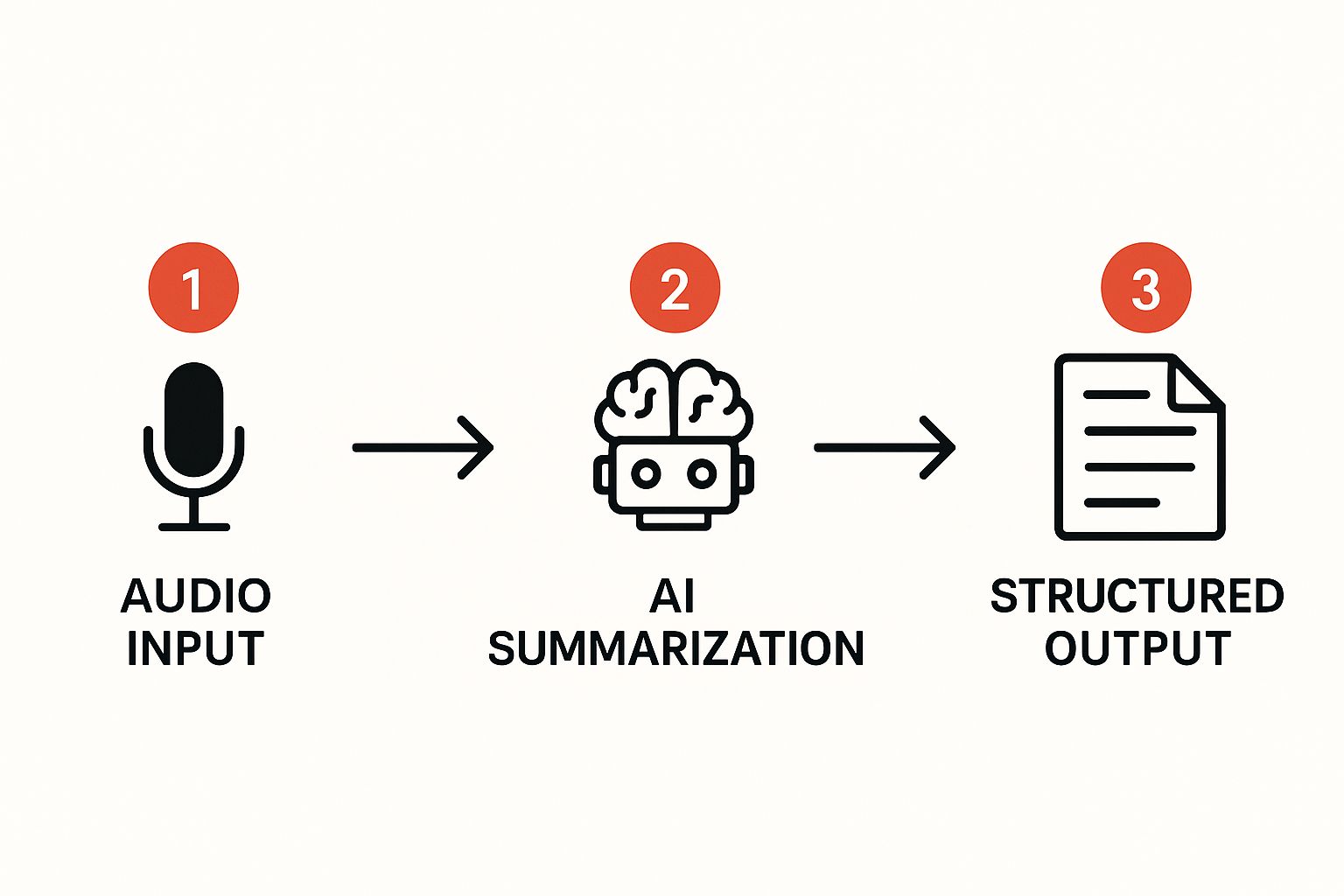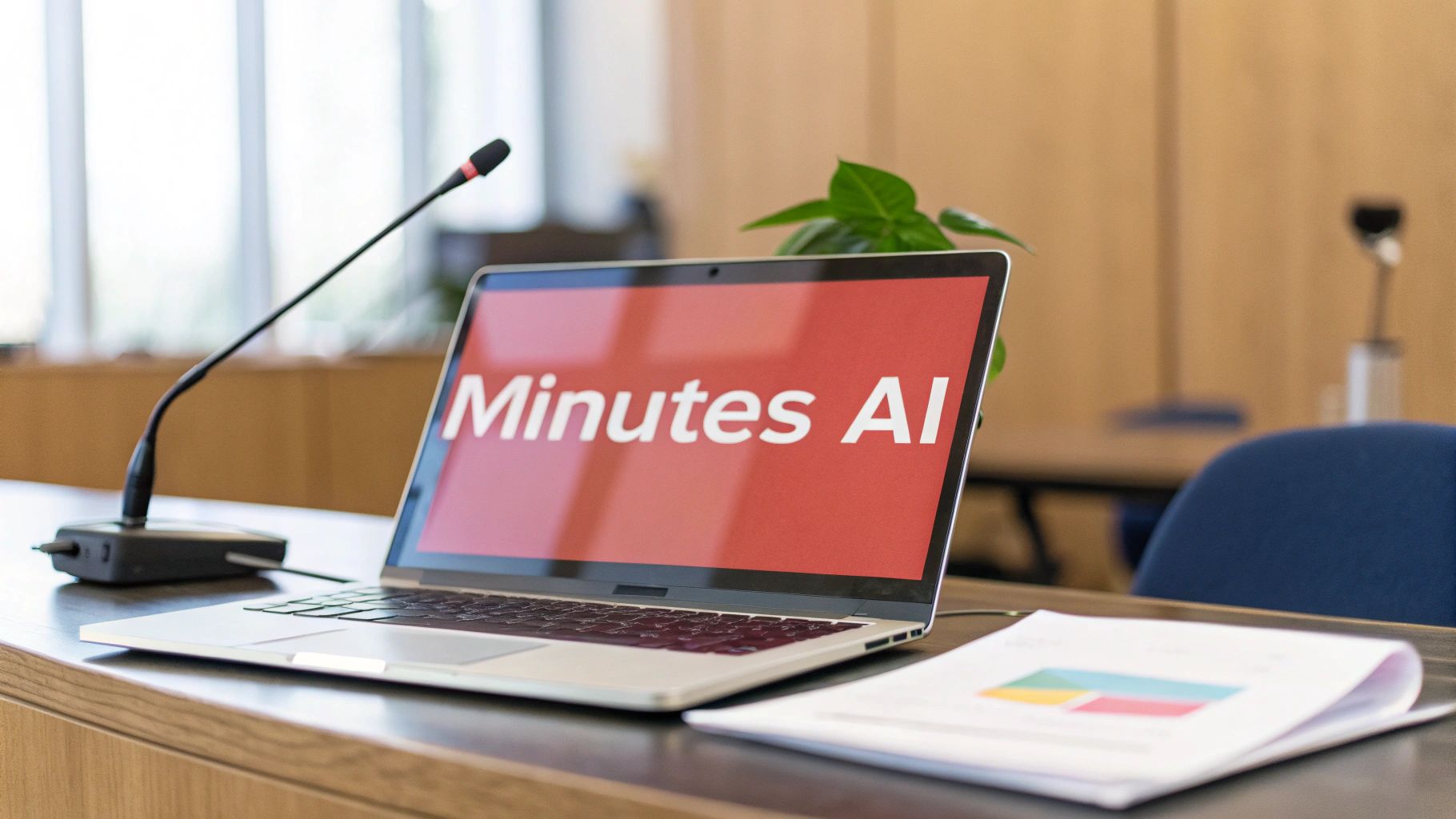Picture this: every client call, every internal brainstorm, perfectly documented the second it ends. That's no longer a futuristic fantasy. It's the reality with meeting minutes AI, a smart way for agencies to get back billable hours, drive accountability, and make sure no brilliant idea or critical decision ever gets lost in the shuffle. These tools work in the background to transcribe, summarize, and organize your meetings, turning talk into action.
Why Manual Note-Taking Is Costing Your Agency Money

If you work at an agency, you know that time is money. It’s your most precious resource. But how many billable hours does your team lose every week to the thankless task of taking notes during client calls, project check-ins, and creative sessions? It’s not just a time-sink; it’s a process riddled with potential for human error, missed details, and biased interpretations that can damage client relationships.
Think about it. When a project manager is frantically trying to scribble down every word, they're not truly in the meeting. They can't fully engage with the client or contribute their best ideas. A subtle piece of client feedback gets missed, a key decision is remembered slightly differently by two people, and suddenly you’re dealing with misaligned expectations and expensive rework.
Shifting Your Team's Focus From Admin Tasks to Client Strategy
At its core, the problem with manual notes is that it pushes your most skilled people into an admin role. Your top strategist shouldn't be your designated scribe. Their brainpower is better spent solving a client's problem, not just capturing what was said about it. This administrative drain directly hits your bottom line by pulling your best talent away from the work that actually generates revenue.
The market is already signaling a massive shift. The global AI meeting assistant space was valued at around USD 2.44 billion in 2024 and is expected to balloon to USD 15.16 billion by 2032. As you can see in the market research data, this isn't just a trend; it's a fundamental change in how productive agencies operate.
By handing off documentation to AI, your team is free to focus on what they were hired to do: deliver incredible value to clients. It’s a simple shift from recording the past to actively shaping the future of a project.
This guide is your roadmap for making that happen. We'll break down exactly how these tools work, what features matter most for agencies, and how to roll them out smoothly. Let’s get started on turning your meeting data into one of your most powerful assets.
How Meeting Minutes AI Streamlines Agency Operations
Let's get past the hype and look at what meeting minutes AI does on the ground, inside a real agency. Picture this tool as your team's most reliable project coordinator—one that sits in on every client call, captures every single detail perfectly, and then neatly organizes it all for the project manager. And it never gets sidetracked.
At its core, this whole process is driven by some seriously smart tech. Natural Language Processing (NLP) is the engine that turns spoken words into an accurate text transcript, which is the raw material for everything that follows. Then, machine learning models kick in to analyze the conversation, figuring out the context to pinpoint key decisions, action items, and important discussion points.
The Automated Workflow for Client Meetings
For an agency, the day-to-day workflow with an AI notetaker is a game-changer. It gets rid of all those manual steps that cause delays and create frustrating communication gaps between your team and your clients.
First, the AI assistant joins the client call, whether it's on Zoom or Google Meet. The best tools do this discreetly, without a clunky "bot" that makes clients feel like they're being recorded by a machine. As everyone talks, it transcribes the entire conversation in real-time.
But the real magic happens the second the call ends:
- Instant Summaries: The tool immediately produces a short, sharp summary of the most important points. No more waiting hours (or days) for someone to write up and send out their notes.
- Action Item Extraction: It automatically pulls out all the tasks that were agreed upon and assigns them to the right people.
- Direct Integration: Those action items can be sent straight into your project management system, whether you use Asana, Jira, or something else. This closes the loop so nothing ever slips through the cracks.
This diagram gives you a clear picture of the AI's core process, showing how it turns a messy conversation into something structured and incredibly useful.

As you can see, the tool takes raw audio and methodically transforms it into a valuable, organized asset for your agency.
From Client Conversation to Actionable Project Intelligence
This automated workflow is about so much more than just saving time on note-taking. It creates a bulletproof system of record. Every decision is documented and every task is logged with clear accountability. It connects what’s said in a client meeting directly to what gets done, which helps cut down on misunderstandings and stops scope creep in its tracks.
By automating the flow of information from client meetings straight into your internal systems, you build a more responsive and transparent operation. This immediate translation of conversation into tasks keeps projects moving forward without manual intervention.
To see how this fits into the bigger picture, it's worth exploring the general workflow automation benefits that can help all parts of an agency run smoother. In the end, this technology ensures everyone—from your team to your key client stakeholders—is on the same page, building trust and leading to much better project outcomes.
Must-Have AI Features That Drive Agency Profitability

Let’s be honest, not all AI meeting tools are built for the fast-paced, high-stakes world of an agency. Basic transcription is fine, but the real value—the kind that protects your time, profit, and client relationships—comes from a few key features. Picking a tool without them is like getting a project management app that can't set due dates. It just misses the point.
The right features elevate a simple transcript into a powerful business asset. They give you the undeniable clarity needed to shut down scope creep, settle disputes with facts, and keep your team and clients on the exact same page. For any agency juggling a dozen projects, this isn't a nice-to-have; it's a must-have.
Clarify Accountability with Speaker Identification (Diarization)
One of the most crucial features is speaker identification, sometimes called diarization. It’s a smart function that figures out who is speaking and labels their words accordingly. Without it, you're left with a giant wall of text. Was that brilliant idea from the client, or was it just your junior designer thinking out loud? Good luck figuring it out.
Imagine a client says, "We'd like to explore adding a video component," and your account manager replies, "Okay, we can look into that." Speaker identification makes sure that exchange is perfectly documented, creating a clear record. It’s your best defense when someone later claims something was or wasn't approved.
Ensure Accuracy with a Custom Vocabulary for Clients and Jargon
Agencies run on jargon. From unique brand names and internal project codenames to super-technical terms, a generic AI is going to stumble and create a messy transcript. A top-tier meeting minutes AI lets you build a custom vocabulary.
Essentially, you can "teach" the AI your clients' specific language, product names, and acronyms. This instantly boosts transcription accuracy, so the final notes look professional and are ready to use without hours of cleanup. It’s a small detail that shows clients you’re paying attention.
A searchable, accurate transcript is more than just a record; it's an objective source of truth. When disagreements arise over deliverables or timelines, you can instantly find the exact moment a decision was made, protecting your agency's bottom line and maintaining client trust.
Accelerate Projects with Automated Action and Decision Tracking
This might be the single biggest feature for boosting profitability. An AI that can automatically spot and pull out action items and key decisions is a game-changer. Instead of a project manager manually combing through notes to create a to-do list, the AI does the heavy lifting in seconds.
This is what keeps projects moving forward.
- Action Items: The AI flags tasks, suggests who should own them, and can often push them straight into your project management software. To really master this, check out our guide on effective action item tracking to see how it keeps projects from stalling.
- Key Decisions: It highlights major approvals and agreements, creating a clear log that anyone can reference to confirm what was decided.
The demand for these smart features is exploding. In 2024, the AI meeting assistant market was valued at around USD 2.53 billion, and it's expected to jump to USD 3.16 billion in 2025. This growth is fueled by the very real return on investment that agencies and other businesses are seeing. You can dig into the numbers yourself by reviewing the latest AI-powered meeting assistant research.
A Checklist of Essential AI Features for Your Agency
When you're shopping for a tool, it helps to connect the dots between a feature and its real-world impact on your agency. The table below breaks down the must-haves and explains exactly why they matter for your team's workflow and your bottom line.
Choosing a tool with this core feature set ensures you're not just getting a transcript, but a complete system for protecting your projects, improving efficiency, and ultimately, keeping clients happy.
How to Select the Right AI Meeting Tool for Your Agency's Needs
The market for AI tools is exploding, and trying to pick the right one for your agency can feel a little overwhelming. But this isn't about chasing the shiniest new toy. It's about finding a tool that actually plugs into how your agency works, keeps your client data safe, and can grow with you. Let’s break down how to make a smart choice that will actually pay off.
The first place to look is your existing tech stack. A meeting minutes AI should feel like it belongs there, not like yet another login your team has to remember. That means you need to hunt for deep, meaningful integrations with the software you already use every single day.
- Project Management: Can it send action items straight into Asana, Trello, or Monday.com? That kind of seamless connection is what keeps projects from stalling because someone forgot to copy and paste a to-do list.
- CRM Systems: Does it play nice with Salesforce or HubSpot? Being able to automatically log client call notes and summaries right into the contact record is huge for keeping a complete history of every conversation.
- Communication Hubs: What about Slack? Getting meeting recaps automatically posted to the relevant project channel is a simple way to keep the whole team on the same page without extra effort.
Prioritizing Security and Scalable Pricing Models
For any agency, client information is everything. That makes rock-solid security a complete non-negotiable. As you look at different tools, dig into their security features. You're looking for things like end-to-end encryption, compliance with privacy laws like GDPR, and clear, granular controls over who can see what. You need to be 100% certain that a confidential client strategy session stays confidential.
Then, there’s the money. Think about how the pricing model will work for you not just today, but a year from now. A per-user price can get out of hand fast as you hire. Look for plans with some flexibility—maybe tiered packages based on features or a set number of transcription hours per month. That can be a much more budget-friendly approach, especially if your project load goes up and down.
A 3-Step Evaluation Process for Choosing Your Agency's Tool
To cut through the noise and make a decision you won't regret, just follow this framework.
- Define Your Agency's Biggest Pain Point: First, figure out what you're actually trying to fix. Are you trying to make sure client deliverables don't get missed? Speed up how quickly your sales team follows up after a pitch? Or just give your project managers back a few hours every week? When you know your "why," you'll know which features matter most.
- Run a Pilot Program with a Single Team: Pick two or three tools that look promising and run a small-scale test. Don't roll it out to the whole company; just give it to a single project team. Have them use it in real meetings—a client kickoff, an internal brainstorm, a creative review. If your agency lives in Google Meet, a good starting point is a purpose-built Google Meet AI note taker.
- Measure the Impact on Workflow and Time Saved: Once the trial is over, get real feedback. Did the tool actually save time? Were the AI summaries accurate enough to be useful? Were the action items correct? Compare the results to the goals you set in step one. The right tool will be the one that delivered.
These tools are popular for a reason—they solve real, nagging problems. It's no surprise that the AI meeting assistant market is growing, with North America making up over 40% of the market in 2024. And with cloud-based options dominating over 65% of sales, it’s clear that scalability and accessibility are key. As you can discover in the full market analysis, the trend is obvious: a secure, cloud-based tool that solves a clear business need is the way to go.
Implementing AI Meeting Minutes: A Rollout Plan for Your Agency

Let’s be honest, bringing in new tech is always more about the people than the software itself. You could get your hands on the best meeting minutes AI available, but if your team doesn't see the point or struggles to use it, you’ve just bought another expensive subscription that gathers digital dust.
A smooth rollout needs a smart plan—one that gets everyone genuinely on board. Think about it like you would a new project management tool. You wouldn't just dump logins in their inbox and wish them luck. You have to show them exactly how it makes their day-to-day work easier, right from the start. That's how a new tool goes from being "one more thing to learn" to an absolute game-changer.
Create Custom Workflows That Fit Your Agency's Meetings
The secret to getting your team to use any new tool is to make it feel like it was built just for them. Generic, out-of-the-box settings are a non-starter. You need to create templates that align with the meetings your team has every single day.
Start by setting up a few essential templates:
- Client Kickoff: Build this template to zero in on capturing project goals, who the key stakeholders are, and what the initial deliverables look like.
- Creative Review: This one should be all about grabbing specific client feedback, logging revision requests, and noting final approvals.
- Internal Brainstorm: Configure this template to pull out fresh ideas, assign research tasks, and define what needs to happen next.
By doing this upfront, you remove all the friction. Your project managers can just pick the right template, and the AI already knows what information is most important to summarize.
The success of any new tool comes down to one simple thing: does it make your team's job easier? If it adds complexity, they'll drop it. If it kills tedious tasks and proves its worth immediately, it'll stick.
Train Your Team for Quick Adoption and Maximum Impact
Your training shouldn't feel like a boring technical manual. It should be a live demonstration of a better way to work. Kick things off with a team session where you use the AI in a real meeting. Don't just tick off a list of features—show them how it solves a universal pain point, like summarizing an hour-long call into a perfect follow-up email in seconds.
After that, give them a simple, clear guide. A one-pager is perfect. It should cover the basics: how to invite the AI assistant to a meeting, where to find the notes afterward, and how to review and share them with clients. Clarity is your best friend here. The simpler you make it for your team to adopt the meeting minutes AI, the faster you'll see a real impact on your agency's efficiency.
Beyond Notes: Using Meeting Intelligence to Future-Proof Your Agency
Getting automated summaries and action items is a fantastic starting point, but it's really just scratching the surface. The true power of adopting meeting minutes AI comes from making the leap to meeting intelligence. This is where your agency stops just recording what was said and starts analyzing it for game-changing business insights.
Think about it: every client call, every internal huddle, every brainstorm is a treasure trove of data. Individually, they're just conversations. But when an AI can connect the dots across all of them, you start seeing patterns you never could before. You might spot a recurring client objection that pops up in 70% of your initial sales calls, giving your team a data-backed reason to refine their pitch.
How Meeting Intelligence Uncovers Hidden Growth Opportunities
Meeting intelligence effectively transforms your messy, unstructured conversations into a clean, searchable database of client needs, team feedback, and project roadblocks. Imagine being able to ask, "What were the main concerns raised during the last three check-ins for Project X?" and getting an instant, accurate answer.
You could discover that a specific type of client feedback consistently derails timelines, allowing you to proactively address it in future project kickoffs. This is how you move from relying on gut feelings to making sharp, strategic decisions based on what’s actually being said in the room.
Adopting meeting minutes AI isn't just about saving time on admin work. It's a foundational step toward building a smarter, more competitive agency by giving you the raw data needed to understand your business at a much deeper level.
Transforming Raw Transcripts into Strategic Business Insights
The insights you can pull are incredibly practical and have a direct impact on your bottom line. For instance, by analyzing your meeting transcripts over time, you can:
- Improve Client Retention: Spot the early warning signs of a client's frustration by tracking sentiment shifts in your calls.
- Boost Sales Performance: Pinpoint the exact phrasing and value props that get prospects excited during discovery calls.
- Optimize Service Offerings: Identify common feature requests or pain points that signal a clear opportunity to launch a new service.
This entire process is the heart of a discipline called Conversation Intelligence, which is all about extracting actionable data from customer interactions. To learn more, check out our guide on what is conversation intelligence.
Ultimately, this approach helps your agency get ahead of problems instead of constantly reacting to them, letting you shape your growth based on the real data locked inside your most important conversations.
Answering Your Agency's Top Questions About Meeting Minutes AI
Bringing any new tool into the fold, especially one that handles client conversations, is bound to raise a few eyebrows. It's smart to ask tough questions. After all, agencies live and die by their client relationships and efficient workflows. Let's tackle some of the most common questions agency leaders have about using AI for meeting minutes.
How Secure Is Our Confidential Client Data with an AI Tool?
This is usually the first and most important question. You're discussing confidential client strategies, unreleased campaign ideas, and sensitive data. The last thing you want is for that information to be compromised.
Thankfully, reputable AI meeting tools are built with security as a top priority, not an afterthought. They understand the stakes.
Look for tools that offer robust security measures like:
- End-to-end encryption, which scrambles your data as it travels, making it unreadable to outsiders.
- Compliance with major data privacy laws like GDPR and CCPA.
- Detailed user access controls, ensuring only the right people on your team can access specific meeting records.
How Accurate Are the AI Transcripts and Summaries in a Real Agency Setting?
Concerns about accuracy are completely valid. While no AI is perfect, the accuracy of modern transcription tools is genuinely impressive, often topping 95% under the right conditions.
What are the "right conditions"? Think clear audio, decent microphones, and trying not to have everyone talk at once. Things like heavy accents or a bad connection can trip up the AI.
But here’s the key: the goal isn’t a flawless, court-reporter-level transcript. The goal is to get a highly accurate draft that saves someone on your team hours of tedious work. The real magic is often in the AI-generated summary, which pulls out the key takeaways and action items, giving you the gist of a 60-minute call in just a few minutes.
Will This AI Tool Integrate with Our Agency's Existing Software?
Nobody wants a new piece of software that creates more work. A good AI tool should feel like it's always been a part of your process, not a clunky add-on. That’s where integrations come in.
The best meeting minutes AI platforms are designed to connect seamlessly with the software your agency already runs on.
You should look for direct integrations with your daily drivers—think Slack, Asana, Trello, HubSpot, or Salesforce. This is what turns a simple transcript into a productivity machine, automatically sending action items to your project boards or logging call notes directly in your CRM. For anything more specific, many tools offer APIs or connect through services like Zapier for custom workflows. As you think about bringing AI into your agency, you'll likely have more questions; check out these answers to general AI tool FAQs to help you get started.
Ready to stop wasting hours on meeting notes and start unlocking valuable insights? Scribbl automatically transcribes, summarizes, and analyzes your client meetings, turning conversations into actionable intelligence. Give your agency the competitive edge it deserves. Discover how Scribbl can transform your agency's workflow.




